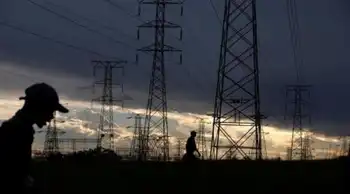FPL experiments with solar thermal
INDIANTOWN, FLORIDA - In former swamplands teeming with otters and wild hogs, one of the nationÂ’s biggest utilities is running an experiment in the future of renewable power.
Across 500 acres north of West Palm Beach, the FPL Group utility is assembling a life-size Erector Set of 190,000 shimmering mirrors and thousands of steel pylons that stretch as far as the eye can see. When it is completed by the end of the year, this vast project will be the worldÂ’s second-largest solar plant.
But that is not its real novelty. The solar array is being grafted onto the back of the nationÂ’s largest fossil-fuel power plant, fired by natural gas. It is an experiment in whether conventional power generation can be married with renewable power in a way that lowers costs and spares the environment.
This project is among a handful of innovative hybrid designs meant to use the sunÂ’s power as an adjunct to coal or gas in producing electricity. While other solar projects already use small gas-fired turbines to provide backup power for cloudy days or at night, this is the first time that a conventional plant is being retrofitted with the latest solar technology on such an industrial scale.
The projectÂ’s advantages are obvious: electricity generated from the sun will allow FPL to cut natural gas use and reduce carbon dioxide emissions. It will provide extra power when it is most needed: when the summer sun is shining, Floridians are cranking up their air-conditioning and electricity demand is at its highest.
The plant also serves as a real-life test on how to reduce the cost of solar power, which remains much more expensive than most other forms of electrical generation. FPL Group, the parent company of Florida Power and Light, expects to cut costs by about 20 percent compared with a stand-alone solar facility, since it does not have to build a new steam turbine or new high-power transmission lines.
“We’d love to tell you that solar power is as economic as fossil fuels, but the reality is that it is not,” Lewis Hay III, FPL’s chairman and chief executive, said on a recent tour of the plant. “We have got to figure out ways to get costs down. As we saw with wind power, a lot has to do with scale.”
For solar power, scale is still a relative term. At its peak, the solar plant will be able to generate 75 megawatts of power, enough for about 11,000 homes. But that is dwarfed by the adjacent gas plant, which can produce about 3,800 megawatts of power. (A megawatt is enough to power a Wal-Mart store.)
Utilities are being pulled in different directions. They must ensure that the lights remain on at all times as well as provide the lowest-cost power to their customers. At the same time, they are being pressed to find ways to reduce their greenhouse gas emissions and invest in renewable power sources.
The latter is critical if the nation is to succeed in reducing its emissions of carbon dioxide. Power plants account for over a third of domestic greenhouse gas emissions that are responsible for global warming.
“We believe there is a cost to society associated with carbon emissions and not having energy security and not having domestic energy supplies,” Mr. Hay said. “But it’s not a level playing field for renewable versus fossil fuels right now.”
Mark Brownstein, an energy and grid specialist at the Environmental Defense Fund, praised FPL’s innovative thinking. “When we talk about getting to a low-carbon, clean-energy economy,” he said, “we know there is not going to be a single technology that is going to transform the industry.”
Currently, 29 states require utilities to increase the amount of power produced from renewable energy, which includes solar, wind, hydroelectric, geothermal and biomass. Last year, Congress considered a federal mandate for 25 percent of renewable power by 2025 as part of its energy and climate legislation. (The bill has since stalled.)
Utilities have been scrambling to meet the state requirements, and many will not be met, according to electrical utility experts.
While renewable power is growing, its share of the nationÂ’s electrical generation remains small. Wind power, which has surged in recent years, accounts for less than 2 percent of the nationÂ’s electrical output. Solar is even smaller. Coal, meanwhile, generates half of the nationÂ’s electrical output, followed by natural gas and nuclear energy.
Part of the challenge in increasing the share of renewable energy sources is to make up for their variable nature — at night, for example, or when the wind does not blow. Because electricity cannot be stored easily, utilities must always produce enough power to meet electric demand at any given time. In practice, this means they need keep a lot of idle plants that can be fired up rapidly when demand spikes.
About 20 percent of the generation capacity overseen by PJM Interconnection, a regional transmission operator covering 13 northeastern and mid-Atlantic states, is used less than 100 hours a year, according to Lester B. Lave, a professor of economics at Carnegie MellonÂ’s school of business.
“As long as the contribution of wind and solar is very small, utilities can handle it very well,” Mr. Lave said. But what happens once the share of renewable power rises to 10 percent? Or 20 percent? “No one knows what the magic number is.”
Spain, which generates more than 12 percent of its electricity from wind, has struggled with wind variability, Mr. Lave said. Similar problems are also cropping up in the United States, especially in states where solar and wind power are on the rise. In 2008, for example, Texas narrowly avoided a blackout when wind power, which supplied 5 percent of demand at the time, experienced an unexpected lull, driving wind electricity generation down to 350 megawatts, from 2,000 megawatts, in less than four hours, according to Mr. Lave.
It is a problem the industry is beginning to focus on, and hybrid plants could provide part of the answer. By adding renewable power to existing fossil fuel plants that operate around the clock, the thinking goes, utilities could have readily available power that could be fired up instantly whenever their wind or solar resources dropped off.
The Electric Power Research Institute is working on two pilot programs that seek to integrate solar power with traditional coal and gas plants in New Mexico. A dozen hybrid projects similar to FPLÂ’s plant are planned around the world, said Cara Libby, the instituteÂ’s project manager for renewable energy.
“Intermittency is probably the challenge utilities are putting the most efforts into researching at the moment,” Ms. Libby said. “The biggest concern, of course, is how to keep the power on.”
Instead of adding new capacity, smart grid designs and investments in transmission lines could also help balance the contribution of intermittent resources, said Tim Stephure, an analyst at Emerging Energy Research, a consulting firm. Some regional operators, such as PJM, are also encouraging their large customers to cut consumption when demand is at its peak to reduce the overall power requirements on the grid, said Mr. Brownstein of the Environmental Defense Fund.
At FPL, part of the challenge will be to fine-tune the system so that its gas and solar components provide just as much electricity as needed at any given time — day or night, cloudy or clear. At a cost of $476 million, the solar project, known as the Martin Next Generation Solar Energy Center, will be second-biggest, after the 310-megawatt Solar Electric Generating System in the Mojave Desert in California. That system, also owned by FPL, was built in the 1980s.
FPL estimates it will cut its natural gas use by 1.3 billion cubic feet each year, the consumption of 18,000 American homes. It will also cut carbon emissions by 2.75 million tons over 30 years, the equivalent of taking 19,000 cars off the road.
The solar panels concentrate the sunÂ’s rays into a vacuum-sealed tube that contains a synthetic oil, which heats up to 748 degrees Fahrenheit. The oil is then used to produce steam that is fed into an existing turbine to produce electricity. Using small sensors, the mirrors will be able to rotate during the day to track the sunÂ’s movement. In case of a hurricane, they will flip upside down for protection.
Related News

Washington Australia announces $600 electricity bill bonus for every household
PERTH - Washington Premier Mark McGowan has announced more than a million households will receive a $600 credit on their electricity account before their next bill.
The $650 million measure will form part of Thursday's pre-election state budget, which has been delayed since May because of the pandemic and will help deflect criticism by the opposition that Labor hasn't done enough to stimulate WA's economy.
Mr McGowan made the announcement on Sunday while visiting a family in the electorate of Bicton.
"Here in WA, our state is in the best possible position as we continue our strong recovery from COVID-19, but times are still…




